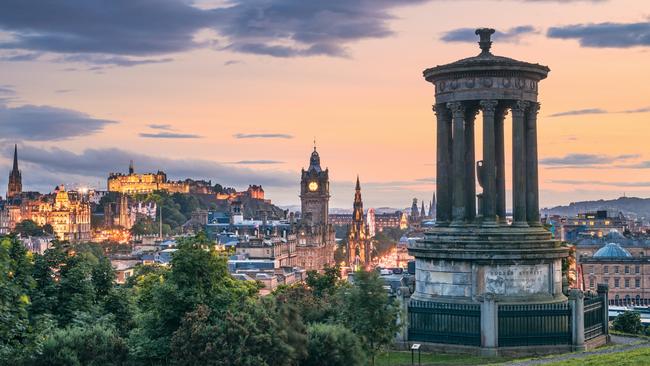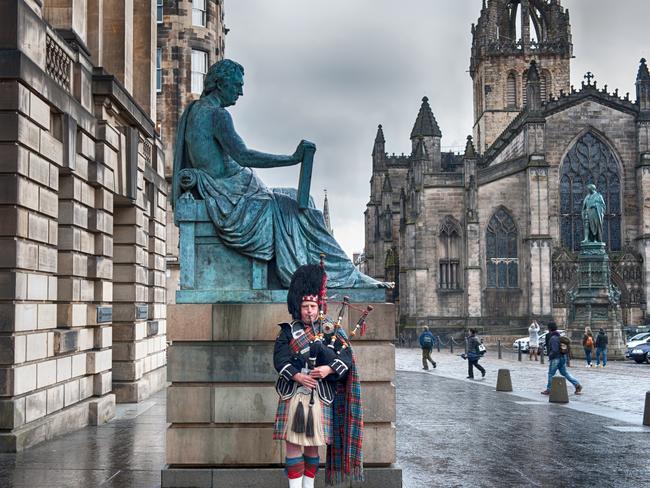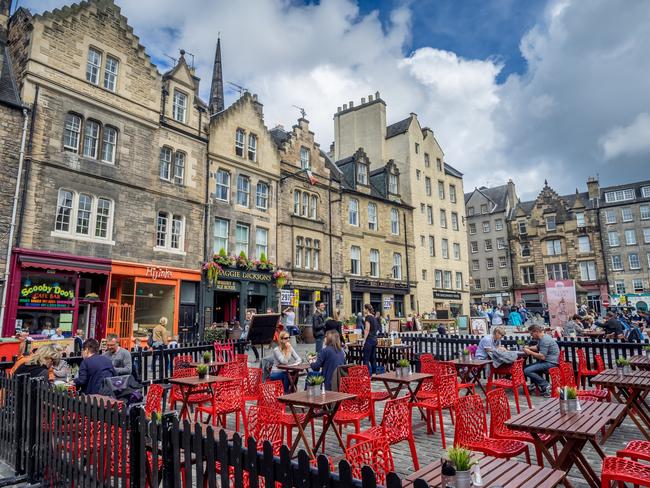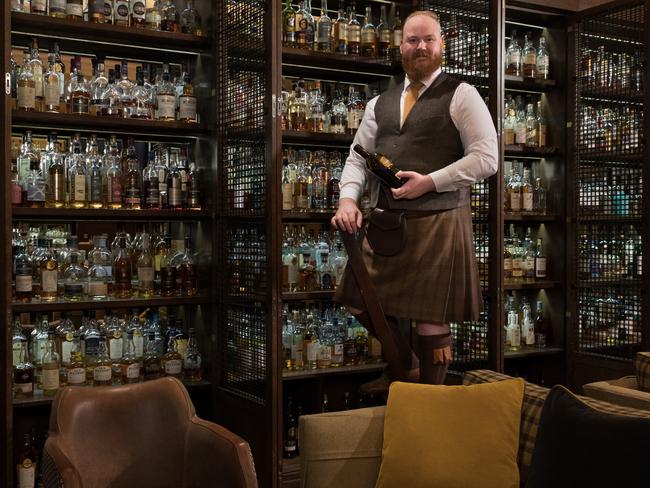Pipe dreams of Edinburgh’s warm embrace
There are those who love the sound of Scotland’s emblematic instrument and those who loathe it.

On Anzac Day, my leafy Sydney neighbourhood in lockdown is filled with the plaintive strains of bagpipes. Scotland the Brave and Waltzing Matilda drift through the gum trees to my living room, and goosebumps prickle up my arms. When the mystery piper’s last note peters out, an audience hidden from view across the gully erupts into applause and cheers.
There are those who love the sound of Scotland’s emblematic instrument and those who loathe it. I was once in the latter camp, but after spending more than two years residing in Edinburgh and driving thousands of kilometres across the country, my conversion was complete. I arrived from London a little lost after six months struggling to find my feet in that unforgiving metropolis. I recall walking out of Edinburgh’s Waverley train station and feeling immediately anchored. Yes, this was a place to call home.
Scotland’s capital quickly gets under the skin. On arrival, visitors are uniformly astonished by its jaw-dropping beauty. Look in one direction and admire the castle atop a volcanic pile. Beneath it is the Old Town’s tangle of tenement buildings and medieval streets and alleys, the names of which reference their colourful, commerce-driven past: Fleshmarket Close, the Grassmarket, Candlemaker Row, the Cowgate.

Look in the opposite direction to the windswept wildness of Arthur’s Seat, the ragged cliffs of Salisbury Crags, and Calton Hill with its unfinished Grecian-style National Monument and tower, resembling an upturned telescope, that commemorates Admiral Lord Nelson. Smack bang in the middle of it all are the Scott Monument and Princes Street Gardens, an oasis of green that attracts sunbathers among the daffodils in the weeks when I am still wearing my winter coat and which, in the bitter depths of January, may be dusted with snow.
The city is monumental in all respects, from its cathedral spires, clock towers and turrets to its tradition-steeped universities and boarding schools; it has more than 4500 heritage-listed buildings. For weeks after my arrival, I marvel at locals going about their daily lives, apparently oblivious to the fact they reside in a veritable museum. They don’t flinch when the boom of the One O’Clock Gun rings out from Castle Rock each day; they barely glance at the castle at all. Given time I, too, will become blase about my surroundings, but for a while lamp posts and roadside kerbs present constant dangers courtesy of my endless gawking.

I have several addresses during my time here but my favourite is an expansive Georgian apartment at the gentrified top end of Leith Walk, which I share with two friendly Scottish lads. The flat’s owner, Kenny, is nursing a broken heart and introduces me to the delights of German hefeweisen at our local pub, the Barony Bar. His flatmate, Ian, is an artist who has a knack for poaching pungent smoked haddock for breakfast only on days when my washing is drying on the clothes rack suspended from the kitchen ceiling. I move in with a backpack and a shiny new Onkyo sound system and we get the party started.
Opposite the apartment is the delicatessen Valvona & Crolla, a den of temptation that’s been trading for 85 years. In a city famous for deep-fried Mars Bars and hot chips with “solt ’n’ soss”, it seems an utterly incongruous slice of Italy. The refrigerated display cabinet is chock-full of naughty cheeses and the shelves stacked with bottles of olive oil treated as reverently as fine wine. Legs of jamon and salami hang from the ceiling. Most of the wares are beyond my purse but I like to linger in the aisles, sampling chunks of bread with oil and balsamic vinegar.
Just up the road is the Scottish National Portrait Gallery, a neo-gothic gem and the first purpose-built repository for portraits in the world. Admission was (and remains) free and it is a perfect place of refuge on wintry days when Edinburgh’s horizontal rain seeps into shoes and chills the bones. The royal blue ceiling of the Great Hall is glorious, dotted in gold with the signs of the zodiac and surrounded by an arched mezzanine and an extravagant frieze depicting Scotland’s history.

In summer, I ride my bike along the Water of Leith, a gurgling stream that for about 800 years powered a dozen or so grain mills around the enchanting Dean Village. I pedal under the great arches of Dean Bridge to the grand sandstone edifice of the National Gallery of Modern Art. If I’m feeling energetic and have company, we venture further afield to the old fishing village of Cramond, where rows of whitewashed terraces look out over the Firth of Forth.
Summer is, of course, when Edinburgh’s population swells by millions for the fringe festival. No wonder there are grumpy-looking folk pushing through the crowds in T-shirts that read “Get out of my way — I live here”; Scottish musician Edwyn Collins sings of the “truly detestable summer festival”. But for an interloper, Edinburgh Festival Fringe is a marathon of adrenaline and whisky-fuelled fun in which we venue-hop from the Gilded Balloon to the Assembly Rooms, the Pleasance Theatre to Whistlebinkies, all squeezed in around my shifts on The Edinburgh Evening News and The Scotsman newspapers.
During my time, those two publications inhabit an ornate Edwardian tower on North Bridge that looks out over the train station to New Town. Built in 1905, it is the most stunning building I’ve worked in. The newspapers have since moved and the landmark has become The Scotsman Hotel, but the newspaper masthead still proudly arches across its facade, the marble staircase and oak-panelled walls remain, and the pigeon lofts, which once housed birds to carry news to far-flung corners of the country, are now a penthouse suite.
If summer is a hedonistic time, winter cloaks the city in a magical aura, especially once the festivities of Christmas and Hogmanay are dispensed with. It can be shockingly cold, so much so that water pipes in some homes freeze then burst in the thaw. Snow is not unheard of, and after one decent fall I make the first snowball of my life, rolling it across the Meadows parkland like a Berenstain bear from the children’s books. Sunrise, if it can be called that, arrives late and after eight hours of cloud-shrouded gloom, night comes early. Lives are conducted largely in the dark.
Thank goodness, then, for all those fabulous pubs. Rug up warmly and walk through the damp, cobbled streets towards a glow as welcome as the beam from a lighthouse on stormy seas. Open the door and be engulfed in a wave of warmth and Scottish brogue. Among countless watering holes to recommend are the historic Sheep Heid Inn, dating from 1360 and boasting a list of past patrons that includes Robert Louis Stevenson, Robert Burns and Bonnie Prince Charlie; the Oxford Bar, which features in Ian Rankin’s Rebus novels; the Canny Man’s, filled with clocks, keys and other curios; and the Bow Bar, an unpretentious establishment that takes its more than 300 whiskies seriously.
Although winter is a favourite time of year, the prospect of enduring that season again, along with Britain’s immigration laws, eventually see me depart Edinburgh. I take with me the Australian man who will later become the father of our two children, a new-found appreciation for the bagpipes, single malt whisky and rugby union, and an abiding love for a city that took me in and made me feel at home.
-
In the know
Stay The Scotsman Hotel, winner of two gongs at this year’s Scottish Hotel Awards. It draws on its newspaper past, combining 115 years of history with classic-contemporary decor; scotsmanhotel.co.uk. Or take a luxury berth on floating hotel Fingal, a former lighthouse tender moored next to Royal Yacht Britannia in the port of Leith; fingal.co.uk.
Do The castle, of course. Other museums and galleries abound so take your pick. Edinburgh is a fabulous pedestrian city and there are plenty of walking tours. Stroll the grand circular places of New Town; people-watch in the Grassmarket; do a tasting at the Scotch Malt Whisky Society; smws.com; catch a rugby match at Murrayfield; scottishrugby.org; put on your dancing shoes for a ceilidh; edinburghceilidhclub.com; see a show; comparetheticketprice.com.

Eat French cuisine meets Scottish produce in a converted whisky warehouse at Michelin-starred The Kitchin in Leith; thekitchin.com.
Another restaurant drawing on the Auld Alliance is Brasserie Prince by Alain Roux at the five-star Balmoral Hotel, which also has a fine whisky bar; roccofortehotels.com.
Moules mariniere is a popular dish, and many restaurants sell kilo and half-kilo pots of mussels with fries and/or crusty bread. Head to The Mussel Inn; mussel-inn.com.
If you want to try cooking haggis, the Macsween brand is readily available and has a palatable blend of ingredients that’s not overpowering; macsween.co.uk.


To join the conversation, please log in. Don't have an account? Register
Join the conversation, you are commenting as Logout